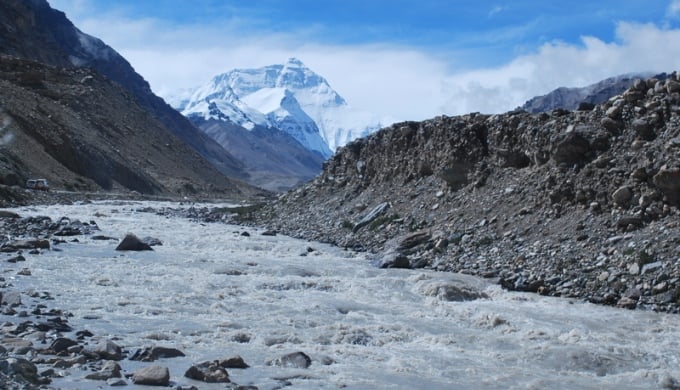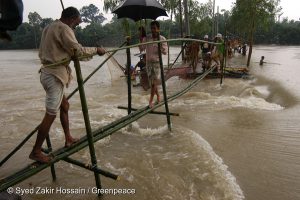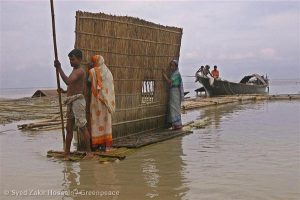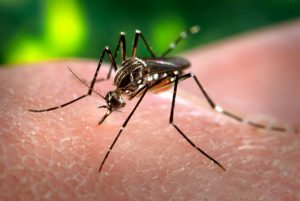Pollutants carried from lands far away and buried for decades under glaciers in the Himalayas are now finding their way into the Ganga and its tributaries, a new study has found. The pollutants are being released as the glaciers are melting faster due to climate change.
Melting glaciers in general are ‘redistributors’ of legacy pollutants stored in them. While they have been shown to release these pollutants in Europe and the US, there had been no study on the Himalayan glaciers.
Now, a study by researchers from India, Norway and the Czech Republic shows that melting Himalayan glaciers can be “major contributors” of two classes of pollutants – polychlorinated biphenyls (PCBs) and polyaromatic hydrocarbons (PAHs) – to the Ganga and its tributaries during the dry season. PCBs are man-made chemicals that were widely used in electrical wires and paint, plastics and rubber products. PAHs occur naturally but are also released into the environment due to burning of coal, coal tar, asphalt, hazardous waste and from vehicle exhausts.
During the non-monsoon dry months in South Asia – eight months of the year – these pollutant loads released by glacier melting can exceed the loads from other sources in the catchment areas of these river basins, says the new study, according to its report in the Environmental Pollution journal.
The scientists, from the Norwegian Institute for Water Research (NIVA), Research Centre for Toxic Compounds in the Environment (RECETOX) at Masaryk University in the Czech Republic and The Energy Resources Institute (TERI), India, analysed air and river water samples, as well as deposits along the Ganga and its major headwaters.
In the central Gangetic plains, compared to pollutants discharged from lower parts of the river basin, the pollutant load from glacial meltwater can be as low as 2% but also as high as 200%, the scientists found. “By remobilising legacy pollutants from melting glaciers, climate change can enhance exposure levels over large and already heavily impacted regions of northern India,” the report says.
“The study provides evidences of high pollution levels of various emerging and legacy hazardous chemicals even in the regions which are far from the dense industrial and agricultural areas,” TERI researcher Girija Bharat explained to thethirdpole.net.
At different sections of the river, the Ganga receives varying amounts of glacial meltwater and industrial effluents, Bharat pointed out. The pollutant load from each source is different. This means that at different sections of the river, the percentage of the pollutant load from each source – glacier or local – is different. The study could not quantify this percentage at various places along the Ganga, as the scientists did not measure the pollutant levels in industrial wastewater and agricultural runoff.
Toxic effects
Although the levels measured in water “are relatively low, especially for PCBs”, nevertheless these substances accumulate and are found in much higher levels in algae and fish, lead author Luca Nizzetto from NIVA said. Levels of PCBs especially tend to magnify throughout the food chain and “will reach top levels in predators and final consumers such as humans.”
PCBs are now banned around the world. In India they were used in for limited purposes until the early 1980s. Globally, the environmental levels of PCBs are declining slowly. “The PCBs emitted from the glaciers, however, were possibly brought to the glacier surface in the past decades by long range atmospheric transport from other regions/countries of the world. Glacier melting is delivering to the Himalayan rivers and the Indian environment this toxic burden released somewhere else, contributing to slowing the decline of PCBs levels in India,” according to Nizzetto.
While Nizzetto’s team does not expect the contaminants surfacing from Himalayan glaciers to cause acute toxic effects, their action could be “subtle and chronic”, and varies from pollutant to pollutant. Some PCBs, for example, disrupt the endocrine hormonal system, and can also accumulate in the fat tissues of humans and be transferred from mothers to children through breast milk.
PAHs can cause cancers, but the danger from these chemicals released into water streams is relatively low. PAHs bind themselves to water molecules as well as particles and debris in a river or stream. So they do not enter the food chain to any great extent from this source. Human exposure to PAHs is mainly through air pollution, especially in cities and industrial districts. PAHs include benzo (a) pyrene – better known as BaP – that is released due to incomplete burning of tobacco, wood and natural gas.
“We do not know exactly what is the total toxic load of the Ganga from a chemical contamination perspective, because of lack of data,” says Nizzetto.
But PCBs released by the glaciers is an additional concern for Indians who are also exposed to other pollutants such as DDT. The two have a cumulative toxic effect.
Himalayan glacial pollution neglected
Compared to the Alps and the polar regions, pollutants in the Himalayan glaciers have not received much attention from policy makers or scientists, says Bharat.
This is despite the Himalayas being important recipients of pollutants transported long distances. It is important to investigate the historically deposited pollutants in the Himalayan glaciers, given their geographical location, surrounded by world’s rapidly growing economies and the densely-populated countries in Asia, Bharat added.
Estimates of the number of people dependent on rivers that flow down the Himalayas vary between 1.4 and 2.5 billion. Bharat said that despite this, “There have been few studies in which the importance of glaciers on a small scale has been explained using mathematical models.”
Water management issues
The study “would like to bring the attention of both policy makers and scientific community to focus more on pristine areas such as the Himalayas,” she added. Another major concern is over “the retrospective approach of current water management policies, which look at water quality after its degradation.”
According to her, industries producing new chemicals should undertake appropriate field trials to assess the potential negative impacts before manufacture, instead of considering such studies solely as the responsibility of scientists.
Bharat said the study assumes importance in the light of two recent initiatives of the India’s Ministry of Water Resources. One is the country’s National Mission for Clean Ganga, which includes rejuvenating the river, and the second is on conservation, development, management and abatement of pollution in the Ganga and its tributaries.
Another important aspect is the expected socio-economic impacts of climate change in India, especially in the Ganga. These include changes in future rainfall patterns and, hence, flows in the river and changes in its water quality. “These changes could affect sources and sinks of contaminants and hence exacerbate future water pollution issues,” Bharat said.
The study “investigates for the first time in India the importance of Indian Himalayan glaciers in fate and distribution of emerging and legacy contaminants in the Ganga basin,” according to the researcher.






